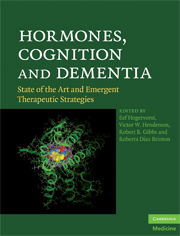Book contents
- Hormones, Cognition and Dementia
- Hormones, Cognition and Dementia
- Copyright page
- Contents
- Contributors
- Preface
- Section 1 Estrogens and cognition: perspectives and opportunities in the wake of the Women's Health Initiative Memory Study
- Section 2 Varieties of estrogenic therapy
- Section 3 Potential modulators and modifiers of estrogenic effects
- Chapter 11 Progesterone regulation of neuroprotective estrogen actions
- Chapter 12 Clinical data of estrogen's effects in the central nervous system: estrogen and mood
- Chapter 13 Different forms of soy processing may determine the positive or negative impact on cognitive function of Indonesian elderly
- Chapter 14 Hypothalamus-pituitary-adrenal axis activity in aging women: its impact on the brain and the potential influence of estradiol
- Section 4 Possible genetic factors related to hormone treatment effects
- Section 5 Testosterone, estradiol and men, and sex hormone binding globulin
- Section 6 Gonadotropin effects
- Index
- Plate Section
Chapter 11 - Progesterone regulation of neuroprotective estrogen actions
from Section 3 - Potential modulators and modifiers of estrogenic effects
Published online by Cambridge University Press: 06 July 2010
- Hormones, Cognition and Dementia
- Hormones, Cognition and Dementia
- Copyright page
- Contents
- Contributors
- Preface
- Section 1 Estrogens and cognition: perspectives and opportunities in the wake of the Women's Health Initiative Memory Study
- Section 2 Varieties of estrogenic therapy
- Section 3 Potential modulators and modifiers of estrogenic effects
- Chapter 11 Progesterone regulation of neuroprotective estrogen actions
- Chapter 12 Clinical data of estrogen's effects in the central nervous system: estrogen and mood
- Chapter 13 Different forms of soy processing may determine the positive or negative impact on cognitive function of Indonesian elderly
- Chapter 14 Hypothalamus-pituitary-adrenal axis activity in aging women: its impact on the brain and the potential influence of estradiol
- Section 4 Possible genetic factors related to hormone treatment effects
- Section 5 Testosterone, estradiol and men, and sex hormone binding globulin
- Section 6 Gonadotropin effects
- Index
- Plate Section
Summary
Estrogen-based therapies often include a progestin to antagonize tumorigenic effects of estrogens in the uterus. While much has been learned about the functional and neuroprotective effects of estrogens in the brain, far less is known about the effects of progestins, particularly specific progestins like progesterone and medroxy-progesterone acetate, used either alone or in combination with estrogenic therapies. In this chapter, Pike and Carroll review many of the effects on cell survival and function, first of estrogens, and then of progestins. While not all progestins are alike, the authors find that prolonged exposure to progestins often will decrease the protective effects of estradiol on cell survival and function. Evidence suggests that a cyclical regimen of estradiol and progesterone may be most efficacious. Ultimately, the development of neural selective estrogen receptor modulators (SERMs) with the potential to circumvent the need for, and hence the negative neural consequences of, progesterone will be an important advance to estrogen-based therapies.
- Type
- Chapter
- Information
- Hormones, Cognition and DementiaState of the Art and Emergent Therapeutic Strategies, pp. 101 - 109Publisher: Cambridge University PressPrint publication year: 2009



